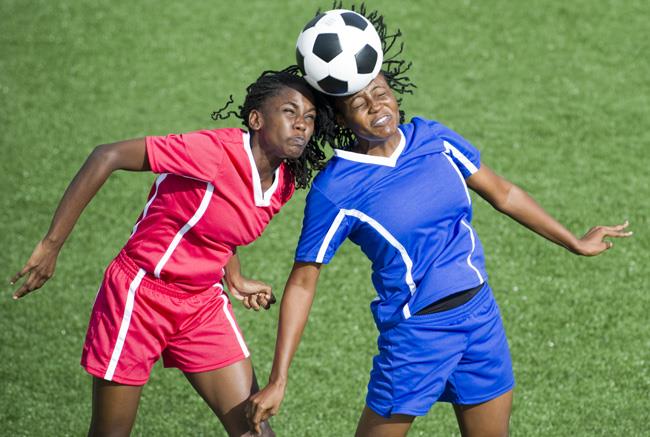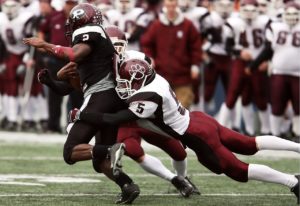Jun 28, 2021Saliva Tests for Concussions: The Next Factor in Diagnosis?
For all the advancements made with the management of athletes’ injuries, concussions still remain a complicated matter for everyone involved. Identifying the long-term side effects has impacted the way everyone approaches them, but there’s still a lot of room for growth. Even when it comes to concussion protocols at a university or the high school level, there’s variance.
“I can’t speak for every institution because everybody’s going to have a different concussion protocol,” St. Mark’s School of Texas in Dallas athletic trainer Natalie Bumpas said. “But we’re going through the cognitive steps. We have a checklist that we use on the sidelines that we have — not only cognitive questions, but depending on how the injury happened, we are also looking at them for an obvious deformity or injury. Nose bleeds or swelling where they got hit.”
 But there are instances where it’s not as easy to identify when a player has suffered a concussion on the field. Then there are players who want to play through injuries — and sometimes coaches who are only focused on the task at hand: winning. Developments like the ImPACT testing have made a difference when trying to identify an athlete who is concussed.
But there are instances where it’s not as easy to identify when a player has suffered a concussion on the field. Then there are players who want to play through injuries — and sometimes coaches who are only focused on the task at hand: winning. Developments like the ImPACT testing have made a difference when trying to identify an athlete who is concussed.
However, the higher up you go, you’ll start to find athletes who claim they purposely perform poorly on the initial baseline ImPACT test so they can score better if they’re ever required to undergo a test later on.
That’s where the findings from the University of Birmingham come into play. Along with her colleague at the London Institute, Dr. Valentine Di Pietro conducted a test from 2017 to 2019, during which they obtained saliva samples from a group of elite-level male rugby players with the intent being “to investigate the role of salivary small non-coding RNAs (sncRNAs) in the diagnosis of sport-related concussion.”
According to the conclusion from the study Di Pietro et al produced for the British Journal of Sports Medicine, the test “identified unique signatures of concussion in the saliva of male athletes diagnosed with a concussion.”
At first glance, it seems like the complicated, yet delicate process of identifying a concussion has been simplified immensely. While the findings might be helpful, some athletic trainers don’t think that would instantly put an end to all other levels of their concussion protocols.
“It’s an interesting concept, but I wouldn’t weigh that as the sole component of diagnosing somebody with a concussion,” Keaton Mangi, assistant athletic trainer to both Sacred Heart University’s baseball and field hockey varsity programs, said. “It could help, for sure. But concussions are a multivariable thing. There’s certainly far more than just one indicator of a concussion. If anything, I think it could be a factor (in the testing process).”
 Furthermore, athletic trainers aren’t necessarily looking to diagnose a concussion. They’re trying to identify the symptoms that indicate an athlete suffered a concussion, but the diagnosis is carried out by another party.
Furthermore, athletic trainers aren’t necessarily looking to diagnose a concussion. They’re trying to identify the symptoms that indicate an athlete suffered a concussion, but the diagnosis is carried out by another party.
“We’re going through these cognitive and sideline checklists, but it’s the doctors who are diagnosing the concussions,” Bumpas, formerly an athletic trainer at Northwestern University, said. “It’s not necessarily a simple fix because it’s lab work. So, it’s going to take longer and probably be more expensive.
“Also, in this study, they only tested 150 people. That’s a pretty small sample size of all athletes, and they only tested for males. Is it different for females? Because, obviously, chemical makeup between the sexes can differ.”
» ALSO SEE: Assessing Proper Hydration in Athletes
But for all the apprehension expressed by Bumpas and Mangi, they’d both happily welcome a more efficient way to navigate the complex injuries that are concussions.
“We would love any way to make this easier and more efficient for both the patient and, in my case, the parents, as well as the academic staff with kids being out of taking tests (for a class),” Bumpas said. “I’m sure any athletic trainer would love an easier way to diagnose concussions.
“And I totally understand the development of something to make this simpler and streamlined, but that obviously takes money, too. Would that really be accessible to most people? There’s a lot that goes into it. More needs to be done as far as research goes, but I don’t think any of us are jumping to conclusions with one study.”



